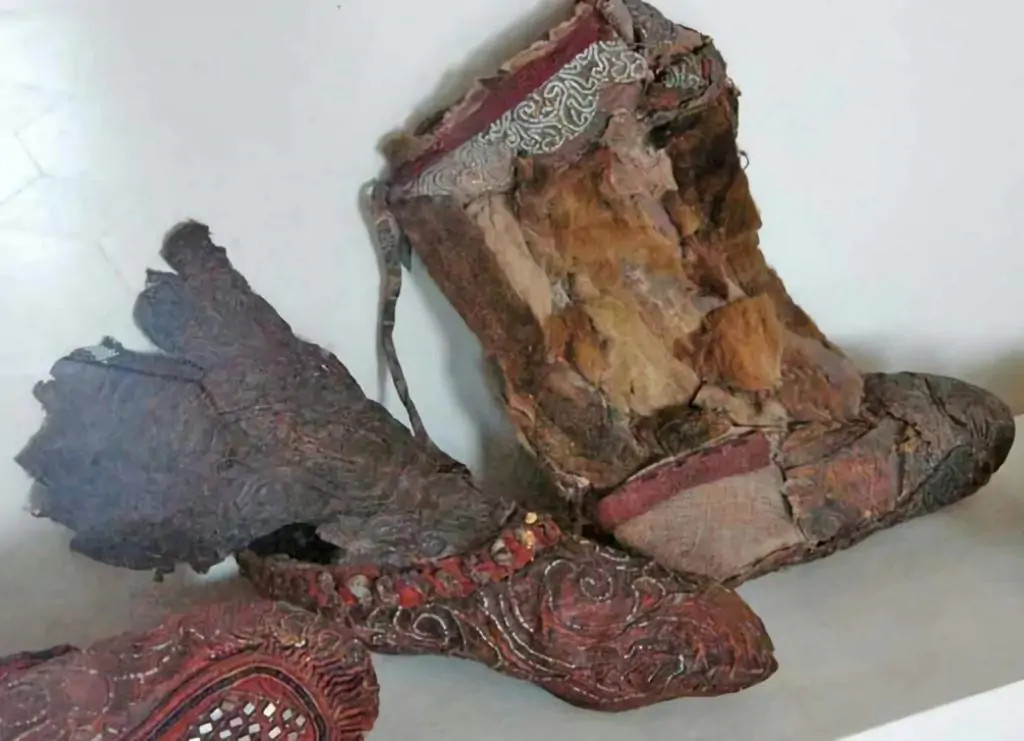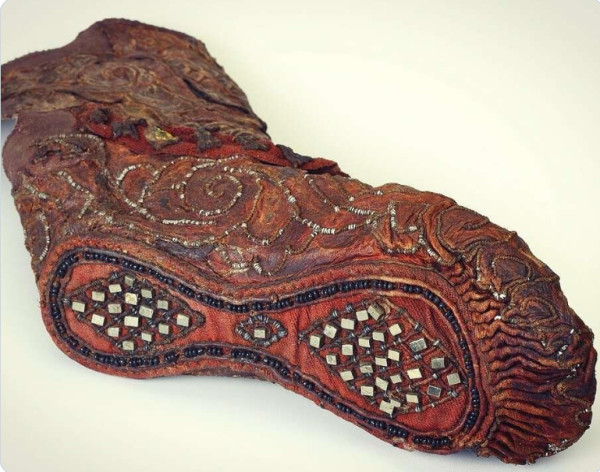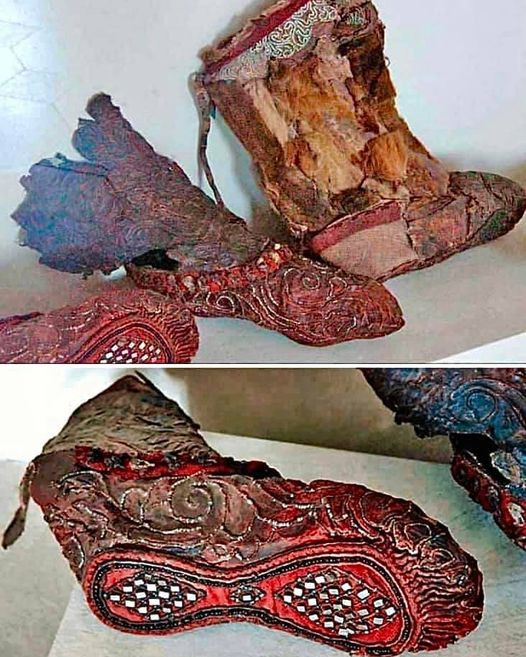In the rugged terrain of Siberia’s Altai Mountains, a remarkable discovery in 1948 opened a window to the ancient past. Archaeologists unearthed a women’s boot, its intricate patterns still intact after 2,300 years. This extraordinary find, accompanied by jewelry, food, and weapons, offers a rare glimpse into the world of the Scythians, a nomadic civilization that once roamed these lands.
The Scythians, who flourished from the 9th to 2nd century BC, were known for their elaborate burial customs. They constructed wooden cabin-like structures deep underground, placing their dead in log coffins surrounded by prized possessions. This practice, combined with the preservative effects of the Altai permafrost, has gifted modern researchers with a treasure trove of well-preserved artifacts.
The Scythian Boot: A Masterpiece Frozen in Time

The Scythian boot stands as a testament to ancient artistry. Crafted from soft red leather, it boasts a geometric design meticulously sewn with pyrite crystals and black beads. The boot’s elaborate sole showcases the exceptional skill of Scythian craftspeople, allowing us to imagine the steps of those who walked these mountains millennia ago.
Craftsmanship That Defies the Ages
The intricate patterns and attention to detail on the Scythian boot are a true marvel. The use of pyrite crystals and black beads to create the geometric design is a testament to the Scythians’ artistic prowess. The boot’s sole, with its intricate carvings and patterns, demonstrates the exceptional skill and craftsmanship of the Scythian people.
A Legacy Etched in Leather

This 2,300-year-old boot is more than just footwear; it’s a tangible link to our ancestors. Its discovery reminds us of the ingenuity, artistry, and spiritual beliefs that shaped the Scythian culture. As we continue to unearth such relics, we deepen our understanding of the rich tapestry of human history that has shaped our world.
The Altai: Nature’s Time Capsule
The Altai Mountains, spanning Central and East Asia, have long been a natural vault for ancient history. The region’s permafrost has preserved not only human remains but also a wealth of artifacts, offering invaluable insights into past civilizations.
The Altai’s permafrost has played a crucial role in preserving the Scythian artifacts found in the region. The cold, dry conditions have allowed for the exceptional preservation of items like the Scythian boot, as well as other artifacts such as jewelry, food, and weapons. This has provided researchers with a unique opportunity to study the Scythian culture in unprecedented detail.

The Altai Mountains have become a veritable time capsule, offering a rare glimpse into the lives and customs of the Scythians. Through the study of these well-preserved artifacts, researchers can gain a deeper understanding of Scythian society, their beliefs, and their way of life. This knowledge helps to fill in the gaps in our understanding of this ancient civilization and its place in the broader tapestry of human history.
The Scythian Way of Death
The Scythians were known for their elaborate burial customs, which have left a lasting impact on our understanding of their culture. They constructed wooden cabin-like structures deep underground, placing their dead in log coffins surrounded by prized possessions.
The Scythians’ burial practices reveal a deep respect and reverence for their deceased. By interring their loved ones with valuable items, they demonstrated a belief in the importance of the afterlife and the need to provide for the departed in the next world. This tradition speaks to the Scythians’ spiritual beliefs and their desire to honor the memory of their ancestors.
The Scythians’ burial customs, combined with the preservative effects of the Altai permafrost, have allowed for the exceptional preservation of their remains and artifacts. This has provided researchers with a unique opportunity to study the Scythian culture in unprecedented detail, shedding light on their way of life, their beliefs, and their place in the broader tapestry of human history.

Conclusion
The discovery of the Scythian boot in the Altai Mountains is a testament to the enduring legacy of this ancient civilization. Through the study of this remarkable artifact and the wealth of preserved items found in the region, we can gain a deeper understanding of the Scythians’ artistry, ingenuity, and spiritual beliefs.
As we continue to uncover the secrets of the past, the Altai Mountains remain a natural vault for ancient history, offering a window into the lives and customs of our ancestors. The Scythian boot, with its intricate patterns and masterful craftsmanship, serves as a tangible link to a bygone era, reminding us of the rich diversity and complexity of the human experience.
By exploring the Scythian legacy, we can not only appreciate the remarkable achievements of this ancient civilization but also reflect on the enduring human desire to create, to honor the past, and to leave a lasting imprint on the world. The Scythian boot, a timeless treasure frozen in time, invites us to celebrate the ingenuity and resilience of the human spirit.
